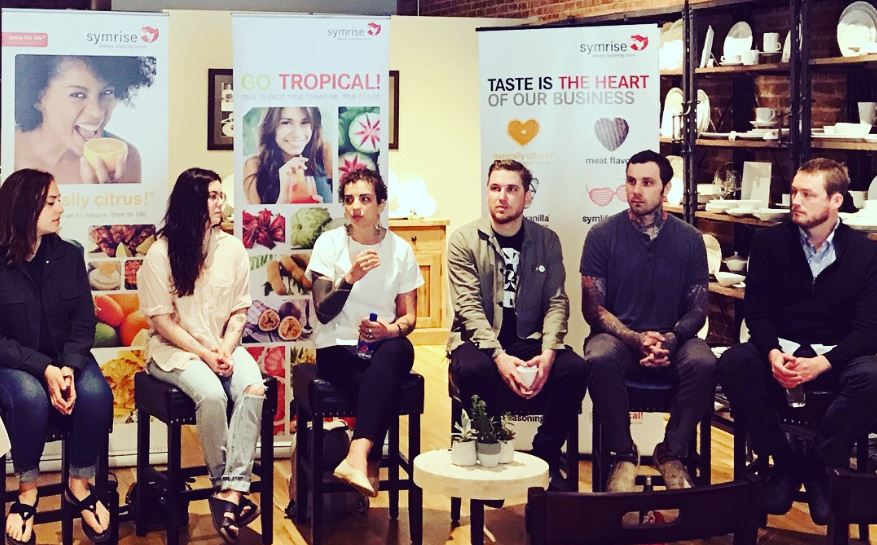The StarChefs “Rising Star Innovation Roundtable” in Chicago, sponsored by Symrise, looked at the ingredients and methods of culinary creativity employed by some of the Windy City’s top chefs. Moderator Emmanuel Laroche, Symrise’s VP of Marketing & Consumer Insight Driven Innovation, continued delving into what stimulates the Young Turks of the Midwest food scene to choose the flavors and formats they focus on.
Need More Seasonal Inspiration? Sign Up For Weekly Insights!
Pastry chef Leigh Omilinsky, of Nico Osteria; chef Ryan Pfeiffer, from the Chicago food landmark, Blackbird; chef Noah Sandoval, from Oriole; pastry chef Emily Spurlin, from the “mostly vegetarian” restaurant Bad Hunter; third-generation meat master Brian Ahern, from Boefhaus; and mixologist Jacyara Di Oliveira of El Che Bar had already presented attendees their take on the flavors and flavor combinations inspiring their recipe development process. Here, they pondered a previous query Laroche, “Does the menu tell a whole story, and is there a theme that starts you off?”  The original question was stimulated by the recognition that chefs Brian Ahern of Boefhaus and Ryan Pfeiffer of Blackbird gave to the input of their staff in the creative process. The other chefs quickly agreed. For the audience members used to the archetype of the head chef as undisputed source of all recipes a restaurant offers, this collaborative approach was both refreshing and insightful. When it comes to manipulating flavors and textures into exciting recipes, many hands can make for inspiring work.
The original question was stimulated by the recognition that chefs Brian Ahern of Boefhaus and Ryan Pfeiffer of Blackbird gave to the input of their staff in the creative process. The other chefs quickly agreed. For the audience members used to the archetype of the head chef as undisputed source of all recipes a restaurant offers, this collaborative approach was both refreshing and insightful. When it comes to manipulating flavors and textures into exciting recipes, many hands can make for inspiring work.
Noah Sandoval, from Oriole, was the first to chime in on the menu question. “We’re trying to move toward the idea of themes but not [in the usual sense] he says. “For example you have to cleanse the palate before dessert. An acid, a salt, something. Starting out with vegetarian or pasta course...”
Sandoval, supported by the other chefs at the table, pointed out that menus are flexible by nature and themes can be just one tool in the development scheme. “The thing about having 15 courses is that each one does not have to be balanced in itself,” he expounded.
One audience member expressed surprise, asking, “With a tasting menu, don’t you think you need to have a theme? Another asked, “Should there be themes in consumer products?”
Leah Omilinsky, of Nico Osteria, answered, “It’s great in theory, but consumers are set in their ways and very few are ready or interested in that kind of experience. The consumer is not totally there yet — they want their blueberry dessert or chocolate ‘something’.”
RELATED: Exclusive Interview With Chris Amirault: Seasonality In The Cocktail Space
While some of the chefs noted that themes in certainly exist, such as the seasonal pumpkin spice trend, Omilinsky clarified her take on the concept of seasonality as a viable theme for CPGs. “I think consumer products is an opportunity to get consumers to try something that’s not in season or not familiar. [A seasonal theme is] a good platform, but as a whole approach, it’s hard – we’re in a culture where you can get whatever you want at any time.”
Continuing with the idea of seasonality as a theme, Laroche asked Brian Ahern, from Boefhaus how one would approach that idea in a steakhouse. “We just let the beef be the beef,” Ahern stated. “We can do whatever we want with the rest of the menu, but we only use salt and pepper with the beef, cooked in cast iron. The menu is balanced, there’s a vegetable component, sauces — but I also want to give the employees their [creative] outlet. As for seasonal produce, he noted, “We are using rhubarb in a lot of places.”
“We just let the beef be the beef,” Ahern stated. “We can do whatever we want with the rest of the menu, but we only use salt and pepper with the beef, cooked in cast iron. The menu is balanced, there’s a vegetable component, sauces — but I also want to give the employees their [creative] outlet. As for seasonal produce, he noted, “We are using rhubarb in a lot of places.”
Shifting gears to staying on trend, Laroche asked Blackbird’s Ryan Pfeiffer about managing consumer expectations of traditional menus, pointing out Blackbird’s 20 years of being in the dining spotlight.
“Everybody is an ‘expert’ in food now,” noted Pfeiffer. “The consumers’ perception becomes our reality as soon as they walk in the door. It’s hard to uphold a standard in a 20-year restaurant that has had different chefs. I don’t have control over everything as I’d like, but you have to roll with the punches. It’s also difficult when you have a constant customer flow.”
Applying consumer ingredients expectations to the seasonality idea, Pfeiffer continued. “You take things you can get that are plentiful and find a way to preserve them for when they’re not in season. You have to have a squirrel mentality and find a way that you can make it in order to keep it good or even make it better.”
Hungry For More? Subscribe To The Weekly In-Sights Newsletter!
The chefs then shifted their focus to the difference in consumer expectations and experiences according to the meal event itself. Noted Pfeiffer, “Lunch is an entirely different animal. The restaurant doesn't move forward without all the rest of the employees — the cooks — moving forward. Your menu has to be 100% entrusted to the people who do it for you.” He noted, however, that the collaborative experience is what makes the whole machine that is a restaurant function successfully. “For lunch, the menu comes from the cooks. They bring it to me and we figure out how to present it in a way that conforms to the restaurant.”
Asking how to accomplish such a democratic process, Laroche brought into the forefront the idea of preserving the identity of an institution. “You make the staff and their ideas feel welcome; you have to teach them and work with them,” explained Pfeiffer. Leah Omilinsky, of Nico Osteria, agreed. “I have a pastry team of eight and we have specific projects since we’re part of the hotel. We have different outlets — banquets, etc. [for creativity]. There’s room for everything, and while there’s fear of failure, I make them feel it’s OK to fail. They come to me with an idea, and I let them do it — bring it to me, and then we’ll work with it to either find out what went wrong or how to make it better. It’s a learning experience.”
Leah Omilinsky, of Nico Osteria, agreed. “I have a pastry team of eight and we have specific projects since we’re part of the hotel. We have different outlets — banquets, etc. [for creativity]. There’s room for everything, and while there’s fear of failure, I make them feel it’s OK to fail. They come to me with an idea, and I let them do it — bring it to me, and then we’ll work with it to either find out what went wrong or how to make it better. It’s a learning experience.”
Emily Spurlin takes the concept further at Bad Hunter. “Teamwork is important, but I recently became aware that it is all about the cooks having trusted me with their careers, and we do a lot of collaboration, finding a middle way between having [their idea] fit the restaurant and the concept, and having them be able to express the creativity. I get them to think outside the box of what is dessert and what can be used. A lot of collaboration also happens between the chef’s side and the pastry side.”






